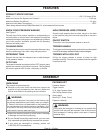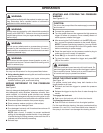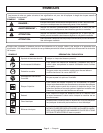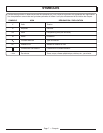
Page 13 — English
WARNING:
When servicing, use only identical replacement parts.
Use of any other parts may create a hazard or cause
product damage.
WARNING:
Always wear eye protection marked to comply with
ANSI Z87.1. Failure to do so could result in objects be-
ing thrown into your eyes, resulting in possible serious
injury.
WARNING:
Before inspecting, cleaning or servicing the machine, shut
off engine, wait for all moving parts to stop, and discon-
nect spark plug wire and move it away from spark plug.
Failure to follow these instructions can result in serious
personal injury or property damage.
GENERAL MAINTENANCE
Avoid using solvents when cleaning plastic parts. Most
plastics are susceptible to damage from various types of
commercial solvents and may be damaged by their use. Use
clean cloths to remove dirt, dust, oil, grease, etc.
WARNING:
Do not at any time let brake fluids, gasoline, petroleum-
based products, penetrating oils, etc., come in contact
with plastic parts. Chemicals can damage, weaken or
destroy plastic which may result in serious personal
injury.
Only the parts shown on the parts list are intended to be
repaired or replaced by the customer. All other parts should
be replaced at an authorized service center.
NOZZLE MAINTENANCE
Excessive pump pressure (a pulsing sensation felt while
squeezing the trigger) may be the result of a clogged or
dirty nozzle.
Unplug the pressure washer.
Turn off the pressure washer and shut off the water
supply. Pull trigger to release water pressure.
Remove the nozzle from the spray wand.
NOTE: Never point the spray wand at your face.
Using a straightened paper clip or nozzle cleaning tool
(not provided), free any foreign materials clogging or
restricting the nozzle.
Using a garden hose, flush debris out of nozzle by back
flushing (running the water through the nozzle backwards
or from the outside to the inside).
Reconnect the nozzle to the spray wand.
Turn on the water supply.
CLEANING THE DECK NOZZLES
See Figure 15.
There are two deck nozzles located under the cleaning
deck. If these nozzle become clogged, it may be necessary
to clean them.
To clean nozzles:
Unplug the pressure washer.
Turn off the pressure washer and shut off the water
supply. Pull the trigger to release water pressure.
Tilt the cleaning deck backwards to expose the spray
bar.
With a wrench, remove the holders from each end of the
spray bar then lift the nozzle from the holder.
Using a straightened paper clip or nozzle cleaning tool
(not provided), free any foreign materials clogging or
restricting the nozzle.
Using a garden hose, flush debris out of nozzle by back
flushing (running the water through the nozzle backwards
or from the outside to the inside).
Slide the nozzle back into the holder.
Place the holder and the spray bar and retighten.
CHANGING THE HIGH PRESSURE FILTER
See Figure 16.
Once you have cleaned the deck nozzles, if the water still
doesn’t flow freely from the spray bar, it may be necessary
to replace the high pressure filter.
To replace the filter:
Unplug the pressure washer.
Place a flathead screwdriver in the cleaning deck inlet
plug. The slot in the top of the filter will cause it to turn
so it can be lifted out of the machine.
Once the filter is removed from the inlet plug, replace it
with a new filter (not included).
Using a flat head screwdriver, turn the filter until it can no
longer be seen over the top of the inlet plug.
STORING THE PRESSURE WASHER
Allow 30 minutes of “cool down” time before storing the
machine. Store in a dry, covered area where the weather
can’t damage it.
It is important to store this product in a frost-free area. Always
empty water from all hoses, the pump, and the detergent
container before storing.
NOTE: Use of a pump saver will give you better performance
and increase the life of the machine.
MAINTENANCE


















